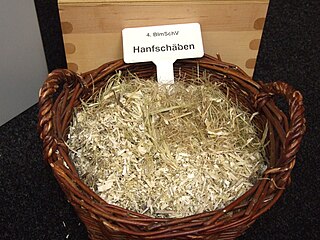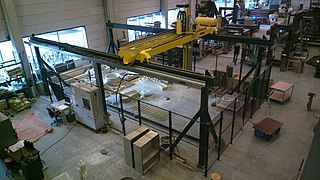
Concrete is a composite material composed of aggregate bonded together with a fluid cement that cures to a solid over time. Concrete is the second-most-used substance in the world after water, and is the most widely used building material. Its usage worldwide, ton for ton, is twice that of steel, wood, plastics, and aluminium combined.

Building material is material used for construction. Many naturally occurring substances, such as clay, rocks, sand, wood, and even twigs and leaves, have been used to construct buildings and other structures, like bridges. Apart from naturally occurring materials, many man-made products are in use, some more and some less synthetic. The manufacturing of building materials is an established industry in many countries and the use of these materials is typically segmented into specific specialty trades, such as carpentry, insulation, plumbing, and roofing work. They provide the make-up of habitats and structures including homes.

Aggregate is the component of a composite material that resists compressive stress and provides bulk to the composite material. For efficient filling, aggregate should be much smaller than the finished item, but have a wide variety of sizes. Aggregates are generally added to increase the strength of composite materials. For example, the particles of stone used to make concrete typically include both sand and gravel. Many construction cement add in aggregates to increase its mechanical strength. Aggregates make up 60-80% of the volume of concrete and 70-85% of the mass of concrete.

Silica fume, also known as microsilica, is an amorphous (non-crystalline) polymorph of silicon dioxide, silica. It is an ultrafine powder collected as a by-product of the silicon and ferrosilicon alloy production and consists of spherical particles with an average particle diameter of 150 nm. The main field of application is as pozzolanic material for high performance concrete.
Soil cement is a construction material, a mix of pulverized natural soil with small amount of portland cement and water, usually processed in a tumbler, compacted to high density. Hard, semi-rigid durable material is formed by hydration of the cement particles.
Superplasticizers (SPs), also known as high range water reducers, are additives used for making high-strength concrete or to place self-compacting concrete. Plasticizers are chemical compounds enabling the production of concrete with approximately 15% less water content. Superplasticizers allow reduction in water content by 30% or more. These additives are employed at the level of a few weight percent. Plasticizers and superplasticizers also retard the setting and hardening of concrete.
Air entrainment in concrete is the intentional creation of tiny air bubbles in a batch by adding an air entraining agent during mixing. A form of surfactant it allows bubbles of a desired size to form. These are created during concrete mixing, with most surviving to remain part of it when hardened.
Engineered Cementitious Composite (ECC), also called Strain Hardening Cement-based Composites (SHCC) or more popularly as bendable concrete, is an easily molded mortar-based composite reinforced with specially selected short random fibers, usually polymer fibers. Unlike regular concrete, ECC has a tensile strain capacity in the range of 3–7%, compared to 0.01% for ordinary portland cement (OPC) paste, mortar or concrete. ECC therefore acts more like a ductile metal material rather than a brittle glass material, leading to a wide variety of applications.
The water–cement ratio is the ratio of the mass of water to the mass of cement used in a concrete mix:
Fiber-reinforced concrete or fibre-reinforced concrete (FRC) is concrete containing fibrous material which increases its structural integrity. It contains short discrete fibers that are uniformly distributed and randomly oriented. Fibers include steel fibers, glass fibers, synthetic fibers and natural fibers – each of which lend varying properties to the concrete. In addition, the character of fiber-reinforced concrete changes with varying concretes, fiber materials, geometries, distribution, orientation, and densities.

A sieve analysis is a practice or procedure used in geology, civil engineering, and chemical engineering to assess the particle size distribution of a granular material by allowing the material to pass through a series of sieves of progressively smaller mesh size and weighing the amount of material that is stopped by each sieve as a fraction of the whole mass.
Self-consolidating concrete or self-compacting concrete (SCC) is a concrete mix which has a low yield stress, high deformability, good segregation resistance, and moderate viscosity.
Copper slag is a by-product of copper extraction by smelting. During smelting, impurities become slag which floats on the molten metal. Slag that is quenched in water produces angular granules which are disposed of as waste or utilized as discussed below.

Concrete is produced in a variety of compositions, finishes and performance characteristics to meet a wide range of needs.
Concrete has relatively high compressive strength, but significantly lower tensile strength. The compressive strength is typically controlled with the ratio of water to cement when forming the concrete, and tensile strength is increased by additives, typically steel, to create reinforced concrete. In other words we can say concrete is made up of sand, ballast, cement and water.
This glossary of structural engineering terms pertains specifically to structural engineering and its sub-disciplines. Please see glossary of engineering for a broad overview of the major concepts of engineering.

Shives, also known as shoves, boon or hurd, are the wooden refuse removed during processing flax, hemp, or jute, as opposed to the fibres (tow). Shives consist of "the woody inner portion of the hemp stalk, broken into pieces and separated from the fiber in the processes of breaking and scutching" and "correspond to the shives in flax, but are coarser and usually softer in texture". Shives are a by-product of fiber production.

Self-healing concrete is characterized as the capability of concrete to fix its CRACKS on its own autogenously or autonomously. It not only seals the cracks but also partially or entirely recovers the mechanical properties of the structural elements. This kind of concrete is also known as self-repairing concrete. Because concrete has a poor low shreanth compared to other building materials, it often develops cracks in the surface. These cracks reduce the durability of the concrete because they facilitate the flow of liquids and gases that may contain harmful compounds. If microcracks expand and reach the reinforcement, not only will the concrete itself be susceptible to attack, but so will the reinforcement steel bars. Therefore, it is essential to limit the crack's width and repair it as quickly as feasible. Self-healing concrete would not only make the material more sustainable, but it would also contribute to an increase in the service life of concrete structures and make the material more durable and environmentally friendly.

3D concrete printing, or simply concrete printing, refers to digital fabrication processes for cementitious materials based on one of several different 3D printing technologies. 3D-printed concrete eliminates the need for formwork, reducing material waste and allowing for greater geometric freedom in complex structures. With recent developments in mix design and 3D printing technology over the last decade, 3D concrete printing has grown exponentially since its emergence in the 1990s. Architectural and structural applications of 3D-printed concrete include the production of building blocks, building modules, street furniture, pedestrian bridges, and low-rise residential structures.









